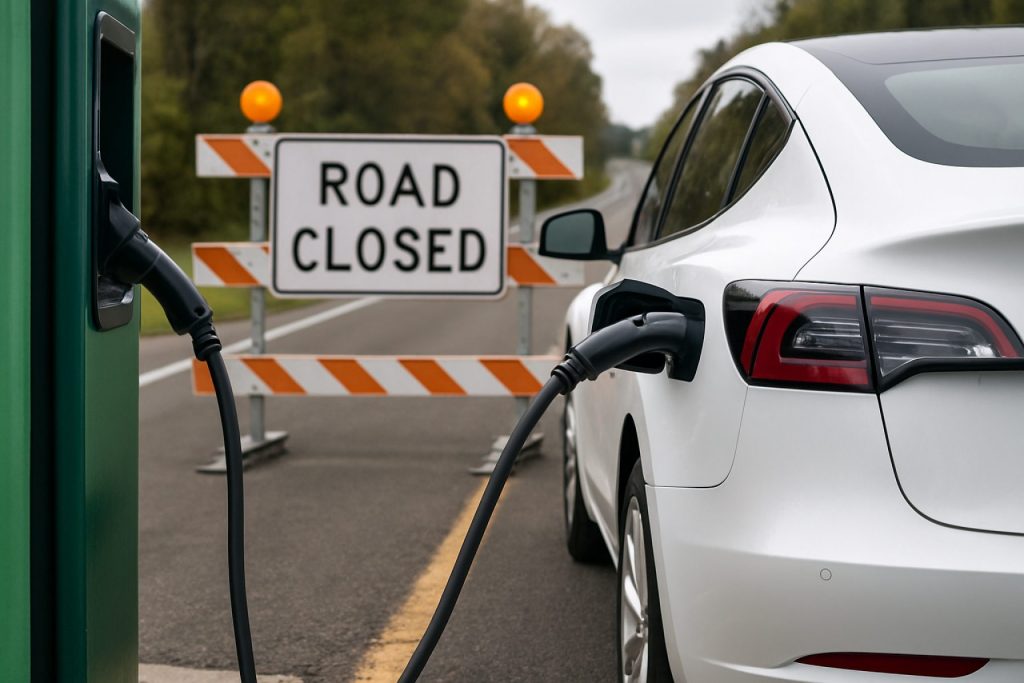
- Electric vehicle (EV) adoption is accelerating in the U.S., with over 1.1 million new EVs sold in 2023 and projections for even steeper growth ahead.
- Charging infrastructure lags behind, with around 160,000 public charging ports spread unevenly across the country, compared to 145,000 gas stations.
- Rural and suburban areas face greater “range anxiety” due to charger scarcity, while urban chargers often see long wait times and reliability issues.
- Federal funding and policy support for building new charging stations faces delays and uncertainty, slowing infrastructure expansion.
- The sustainability and impact of the EV movement depend on rapidly scaling and improving charging networks to match growing demand and meet climate goals.
The rise of electric vehicles has electrified imaginations across the globe. Glittering Teslas weave through city streets, while charging stations pepper rest stops from LA to Miami. Each year, more drivers cut ties with gasoline, inspired by clean technology and tightening emissions standards. But behind the shiny promise lies a growing conundrum—an expanding fleet of EVs threatens to outpace the infrastructure designed to power them.
For many, the appeal of electric vehicles is immediate: instant torque, silent rides, and the quiet satisfaction of skipping the gas pump. In 2023, over 1.1 million EVs rolled onto U.S. roads, with experts predicting steep climbs ahead. Automakers from Chevrolet to Ford have doubled down, introducing sleeker, longer-range models and even electrifying trucks and SUVs. Yet, as sales surge, the network that keeps these cars humming faces a critical squeeze.
The Numbers Tell a Charged Story
The United States boasts roughly 160,000 public charging ports scattered across malls, parking garages, and highway corridors—a far cry from the convenient sprawl of over 145,000 gas stations dotting the landscape. While fast-charging stations have multiplied, many remain clustered in urban centers, leaving drivers in rural or suburban areas contemplating nerve-wracking range anxiety. Today, analysts warn, there are already more EVs vying for plugs than there are chargers to satisfy them.
A massive buildout was set in motion by the Biden administration, which earmarked $7.5 billion to create a coast-to-coast charging network. The plan envisions charging stations every 50 miles along major U.S. highways. However, with changing political priorities and debates simmering in Washington, new funding streams and deployment rates now hang in the balance.
More Cars, Fewer Plugs?
Recent policy shifts raise urgent alarms for EV owners and would-be buyers. As government focus pivots and incentives waver, the pace of new charging installations has slowed. State and federal agencies—once flush with infrastructure cash—face growing uncertainty about support for future projects. Meanwhile, private companies seek profits, not universal coverage, often opting to install chargers where usage is highest rather than where need is greatest.
Consider the numbers: California, the vanguard of green driving, sees over 1 million EVs competing for approximately 87,000 publicly accessible chargers. Wait times stretch at busy locations, and “out of service” notices frustrate travelers with low batteries. In less populous states, finding a reliable charger can feel like searching for water in a desert.
Global Lessons—and Warning Lights
The U.S. is not alone in wrestling with these growing pains. Norway, the world’s EV capital, recently saw lines snake for hours during peak travel, while some UK drivers have voiced concerns about reliability and charger access. Industry leaders say the solution demands not just more stations, but smarter ones—systems that quickly identify available plugs, lesson downtime, and fold renewable energy into the grid for a cleaner charge.
What’s at Stake for Drivers (and the Planet)
Without robust charging infrastructure, the EV revolution risks stalling: consumer confidence could drop, resale values could tumble, and would-be converts may stick with internal combustion engines. Clean-tech innovation faces a paradox—technology sprinting ahead, yet hamstrung by lagging support.
This challenge is more than one of convenience—it’s a pivotal moment for global climate goals and local economies. The fate of EV adoption, U.S. competitiveness, and real progress on emissions hinge on whether the necessary investment and planning can keep up with innovation.
For drivers, the message is clear: charging availability must become as reliable as flipping a light switch. Until then, range anxiety will remain a shadow on the open road.
To explore more about the future of green tech and electric mobility, visit The New York Times or follow the latest updates from Tesla.
Key takeaway: The EV dream promises a cleaner tomorrow, but unless the nation plugs the infrastructure gap soon, many drivers may be left waiting for a charge that never comes.
America’s EV Boom: The Charged Truth Behind the Plug Shortage Problem
The Future of Electric Cars: Will Charging Station Chaos Stall America’s Climate Goals?
As electric vehicles (EVs) accelerate onto American highways, the spotlight isn’t just on their impressive torque or zero tailpipes—it’s on whether the nation’s charging network can keep up with the surging fleet. The original article highlighted a stark infrastructure gap, but there are even more layers to the story. Here’s an insider’s guide to the risks, opportunities, market trends, and expert tips every current or future EV driver should know.
EV Charging Infrastructure: Unexplored Facts & Industry Secrets
1. How-To Steps & Life Hacks for Today’s EV Owners
– Plan Ahead: Use dedicated apps (e.g., PlugShare, ChargePoint, Electrify America) to locate reliable fast chargers and check their real-time status.
– Home Charging Hack: Installing a Level 2 charger at home vastly reduces “charger anxiety.” Many states offer rebates for home installation.
– Optimize Timing: Charging during off-peak hours not only saves money with time-of-use rates in some states, but helps the grid manage loads.
2. Real-World Use Cases & Market Forecasts
– Workplace Charging: Over one-third of EV owners rely on workplace chargers, especially in urban areas (Source: U.S. Dept. of Energy).
– Long-Haul Trucking: Electric semi-trucks (like Tesla Semi) could spark new “megacharger” superstations, adding complexity to the public network.
– Market Forecast: S&P Global Mobility predicts the U.S. will need over 2.3 million public chargers by 2030 to serve projected demand—14x the number today.
3. Reviews & Comparisons: Public Charging Networks
– Tesla Supercharger: Fastest and most reliable, but limited to Tesla vehicles (though some locations now open to others).
– Electrify America: Covers many highway corridors; occasional reliability issues reported.
– EVgo & ChargePoint: Widest network in urban centers; slower speeds than DC fast chargers.
4. Controversies & Limitations
– Broken Chargers: A 2022 study from UC Berkeley found roughly 23% of Bay Area public chargers were non-functional at any one time.
– Digital Divide: Many EV charging platforms require apps or RFID cards, which may pose accessibility issues for older adults or non-tech-savvy users.
– Charger Equity: Low-income neighborhoods frequently have fewer charging options, risking a green divide.
5. Features, Specs & Pricing
– DC Fast Chargers: Add 60-200 miles of range in 20-30 minutes, but networked providers often vary by up to 2x in pricing.
– Level 2 Public Chargers: 10-20 miles/hour; often free or provided at cost at workplaces, hotels, or shopping centers.
– Home Chargers: Installation costs range from $500-$2,000 depending on electrical upgrades.
6. Security, Sustainability & Grid Impact
– Cybersecurity Risks: As charging stations become internet-connected, they can be potential vectors for cyberattacks targeting the grid (Source: U.S. GAO).
– Sustainability: Renewably powered stations (solar/wind) help maximize EV climate benefits, but most public stations still rely on conventional electricity.
7. Insights, Trends & Predictions
– Bidirectional Charging: Vehicle-to-grid (V2G) technology, where EVs return energy to the grid, is being piloted in California and New York. This may one day help offset grid strain during peak times.
– Battery Swapping: Companies like NIO in China demonstrate alternative solutions where batteries are swapped, not charged—a model still rare in the U.S.
8. Compatibility & Access
– Universal Adapters: U.S. automakers (GM, Ford, Rivian) announced adoption of the North American Charging Standard (NACS), aligning with Tesla’s plug, reducing fragmentation.
– App Usage: Nearly 80% of EV owners surveyed in 2023 report having 2-3 charging network apps installed.
9. Pros & Cons Overview
Pros:
– Zero tailpipe emissions, supporting climate change goals.
– Lower long-term fueling and maintenance costs.
– Increasing model range and diversity.
Cons:
– Patchy charger access in rural areas and certain urban corridors.
– Occasional price spikes for DC fast charging.
– Infrastructure deployment lags behind car sales.
10. Reader FAQs Answered
Q: Is EV home charging always cheaper than public charging?
A: Usually, yes. Home rates average 13-22 cents/kWh, while public fast charging can cost 30-50 cents/kWh.
Q: Are there government rebates for home charging?
A: Yes, many states offer $500-$1,000 rebates and up to 30% federal tax credit (check current eligibility).
Q: What happens in a blackout?
A: Public chargers go down if grid power fails. Some chargers tied to solar + storage can operate independently, but are rare.
Q: How long does it take to install new charging stations?
A: Permitting and installation can take from 3 months (fast-track urban) to over a year (rural/utility delays), depending on utility engagement and location complexity.
Actionable Recommendations
– If buying an EV, ensure access to home or workplace charging, or map charging options on your regular routes.
– Consider flexible models (plug-in hybrids) if public charging access is limited in your area.
– Use trip planning tools and network apps before long trips to avoid “dead zones.”
– Advocate with local officials for equitable public charging station deployment—especially in underserved communities.
For credible industry updates, see The New York Times or EV manufacturer resources such as Tesla.
Final Takeaway: Reaching the “gas-station-easy” experience with EVs is possible, but not guaranteed yet—policy, innovation, and smart planning must catch up with America’s accelerating EV revolution.
Keywords: electric vehicle charging, EV infrastructure, public charging networks, range anxiety, home EV charger, DC fast charging, EV charging industry trends, electric car market, bidirectional charging, climate goals.



